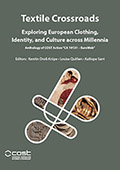Center, Textile Research

Textile Crossroads: Exploring European Clothing, Identity, and Culture across Millennia
Date of this Version
2024
Document Type
Article
Citation
In Textile Crossroads: Exploring European Clothing, Identity, and Culture across Millennia. Anthology of COST Action “CA 19131 – EuroWeb”. Kerstin Droß-Krüpe, Louise Quillien, & Kalliope Sarri, Editors. Zea Books, Lincoln, Nebraska, 2024. DOI: 10.32873/unl.dc.zea.1807
Abstract
Red is the color par excellence, its symbolism being linked with protection and magic through its primary attributes, fire and blood. It was the predominant color from the earliest times, certainly during the Greek and Roman periods and into Medieval Europe, until blue became a competitor around the 13th century. Mineral pigments, like iron oxides, were the first red sources, used to draw lines, dots, or spots on cave walls or stones. Later, other mineral red pigments were also exploited: Cinnabar, natural mercury sulfide, since the Neolithic, and realgar, arsenic trisulfide, in Ancient Egypt. Scientific investigation revealed that, although inorganic pigments were mainly used in painting, iron oxides and cinnabar were also the first available sources for coloring textiles. Plant dyes have been known since the Neolithic, exploited by people living in climatically mild areas rich in vegetation. Their use is strongly connected with two other fundamental textile processes: Spinning and weaving. Scholarly literature indicates Egyptian privet (henna, Lawsonia inermis) as the oldest red vegetal source used. Although widely known as a source of brown, the dried leaves, when powdered and treated with lime water, yield an intense orange red, which is efficient for dyeing the body — skin and hair — and textiles of animal origin. Madder (Rubia tinctorum or relatives) was the first dye to be reported from archaeological European Bronze and Iron Ages textiles preserved in the Hallstatt salt mines, Scandinavian bog sites, and other European burials. Apart from madder, the most widely appreciated red dye sources in the European Classical period were kermes (Kermes vermilio and K. ilicis), purple (species of sea snails from the Muricidae family), and extracts of red tree resins, as dragon’s blood (e.g. Dracaena draco, Dracaena cinnabari, and Daemonorops draco). These sources were used for textile dyeing and as organic pigments in paintings.
Included in
Ancient History, Greek and Roman through Late Antiquity Commons, Archaeological Anthropology Commons, Classical Archaeology and Art History Commons, Classical Literature and Philology Commons, Eastern European Studies Commons, European History Commons, European Languages and Societies Commons, Fiber, Textile, and Weaving Arts Commons, History of Science, Technology, and Medicine Commons, Human Geography Commons, Museum Studies Commons, Place and Environment Commons, Social and Cultural Anthropology Commons, Women's Studies Commons


Comments
Copyright © 2024 by the authors.